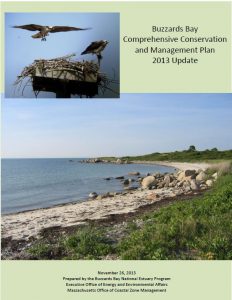2013 CCMP, Action Plan 5:
Managing Onsite Wastewater Disposal Systems
About the new Buzzards Bay CCMP Action Plans
The Buzzards Bay Comprehensive Conservation and Management Plan (CCMP) was updated in November 2013 to reflect the great progress achieved since the original CCMP was finalized. You can download the entire document (buzzards-bay-ccmp-2013-update.pdf) or just this action plan Managing On-Site Wastewater Disposal Systems.
Managing Onsite Wastewater Disposal Systems
Problem
The preponderance of the use of conventional septic systems poses a threat to many embayments and freshwater ponds in the Buzzards Bay watershed. Failed and inadequate septic systems also remain a source of patho-gens contributing to water quality impairments. The 1996 updates to Title 5 required that both new standards and the inspection and replacement of inadequate systems at time of property transfer. These regulations have eliminated many problem systems. However, many properties have not changed hands since 1995, and many inadequate systems remain in place. Moreover, local regulations need to be adopted to address special local environmental needs. This action plan addresses the need for improved and more effective designs for onsite wastewater treatment systems to meet the needs of protecting sensitive areas of Buzzards Bay.
The nutrient impacts of septic systems remain a significant problem, and controlling these eutrophication impacts are addressed in Action Plan 1 Managing Nitro-gen Sensitive Embayments. While there will be a push to sewer many more areas in the Buzzards Bay watershed, homes in the less densely developed areas will continue to use onsite septic systems for years to come, and in some cases may need to be upgraded to nitrogen removing septic systems. The increased use of onsite wastewater systems with alternative designs will pose a management challenge for local and state government.
Goal
Goal 5.1. Prevent public health threats and environmental degradation from on-site wastewater disposal systems.
Objectives
Objective 5.1. Enforce the provisions contained in Title 5 regulations such as, siting and design, inspection and upgrades, training, maintenance, mapping and designation of nitrogen sensitive areas, etc.
Objective 5.2. Where special local conditions exist, encourage boards of health to adopt local regulations to ensure and/or improve environmental and public health protection.
Objective 5.3. Improve management and oversight by municipalities of onsite wastewater disposal systems.
Objective 5.4. In areas where advanced nutrient removal is required, encourage community scale alternative technology systems as a preference over individual alternative systems.
Approaches
To meet the goals of this action plan, installed or up-graded onsite systems must meet all state and local regulations. When appropriate, municipalities must adopt local regulations to meet special local needs to protect public health, safety, and the environment. Some of these local requirements could include more stringent setbacks, or accounting for sea level rise in nearshore areas by increasing separation to groundwater.
For watersheds of embayments listed as nitrogen im-paired on the state impaired waters list, or where warranted by TMDL, or as part of local Comprehensive Water Management Plans (CWMPs) local government can require the use of nitrogen removal septic systems. Such an approach could include nitrogen discharge standards more stringent than the state specified minimum of 19 ppm. As an interim measure, towns could request that DEP designate nitrogen sensitive embayments pursuant to 310 CMR 15.000, Section 15.215(2).
Costs and Financing
Most of the solutions identified in this action plan have negligible costs to government, although some initiatives would increase the workload for staff, or new staff may be required. Some initiatives, like a regional online innovative system tracking system would likely cost less than $10,000 to create, and may cost $10,000 per town to annually staff thereafter. Management solutions that incorporate the use of innovative onsite treatment systems can add to the costs incurred by developers and property owners, but these costs will need to be evaluated and weighed against the costs of conventional sewering.
Measuring Success
For this action plan, programmatic actions are the chief measure to track progress toward the goals of this action plan. Evaluating the effectiveness of local regulations is subjective, and each municipality must assess its needs and define the most effective regulatory solution.
